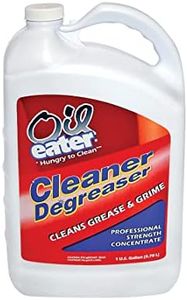We Use CookiesWe use cookies to enhance the security, performance,
functionality and for analytical and promotional activities. By continuing to browse this site you
are agreeing to our privacy policy
7 Best Oil Stain Removers For Concrete
From leading brands and best sellers available on the web.Buying Guide for the Best Oil Stain Removers For Concrete
Choosing the right oil-stain remover for concrete involves understanding the type of stain you're dealing with, the size of the affected area, and how quickly you want to see results. Since concrete is porous, stains can soak in deeply and be tough to remove fully. It's important to think about ease of use, how safe the product is for you and the environment, and whether your surface has any special requirements or coatings. By considering a few key features, you can narrow your options and select an oil-stain remover that matches your cleaning needs and fits your comfort level.Type of FormulaThis refers to the chemical makeup of the oil-stain remover, such as whether it is solvent-based, water-based, or bio-based (like enzymes or microbes). The formula matters because it determines how aggressive or gentle the cleaner is, as well as its safety for users and the environment. Solvent-based removers tend to be more powerful and work quickly on tough, old stains but might have strong fumes or require careful handling. Water-based and bio-based formulas are usually safer and more eco-friendly, suitable for frequent use, new stains, or areas with children or pets. If your stains are light or you prioritize safety and green cleaning, a bio-based or water-based option is a good fit. For older, tough stains, a solvent-based formula may be more effective.
Application MethodThis describes how the stain remover is applied, such as in liquid, spray, powder, or gel form. Application method affects the ease of use, coverage, and how deeply the remover penetrates. Liquid and spray types are easy to use and good for wide areas or vertical surfaces. Powders or poultice products are sprinkled or spread, then left to absorb the stain—ideal for deep or stubborn stains but may take longer. Gels can cling to vertical spots or textured surfaces. Choose an application style that matches your stain size, working area, and comfort—sprays and liquids offer quick coverage for large or spread-out stains, while powders and gels suit tough, localized spots.
Contact TimeContact time means how long the product needs to stay on the stain to work effectively, often ranging from a few minutes to several hours or even overnight. This is important because some removers need more time to break down oil, especially for deep or old stains. Quick-acting formulas are convenient if you want fast cleanup or need to use the area soon, while longer-contact removers may give better results on tough stains if you can let them sit. If you have patience or a particularly stubborn mark, in-depth or overnight formulas can be worthwhile; for routine or quick jobs, choose something with a short contact time.
Residue and Rinse RequirementsThis factor covers whether the remover leaves behind any residue and if rinsing is necessary after use. Some removers simply dry up or can be swept away, making cleanup easy, while others require thorough rinsing with water or scrubbing to remove leftover product or loosened oil. People who want minimal cleanup or have water restrictions will prefer no-rinse or sweep-away formulas. If you’re not worried about using water or extra effort for tough stains, options that need rinsing and scrubbing can be considered.
Surface CompatibilitySurface compatibility indicates whether the remover is safe for all types of concrete or if certain formulations can damage coatings, colored concrete, or adjacent materials like stone or grass. It's important because some powerful chemicals may discolor or erode treated or decorative concrete. Look at the product label or description to ensure it's suitable for your specific surface. If you have plain, unfinished concrete, most removers are safe; for stained, sealed, or decorative concrete, stick with products labeled as non-damaging or safe for all surfaces.
Safety and Environmental ImpactThis spec refers to the product's effect on health and the environment, including issues like fumes, toxicity, harm to plants, or required protective gear. Strong chemical removers might need gloves or masks and should be used in well-ventilated areas. Eco-friendly or plant-safe removers are ideal if pets, children, or landscaping are nearby, or if you're concerned about run-off into drains. For indoor or frequent use, or in sensitive environments, pick a non-toxic and biodegradable formula; if you face an especially bad stain and can safely manage fumes and runoff, stronger options can be considered.






